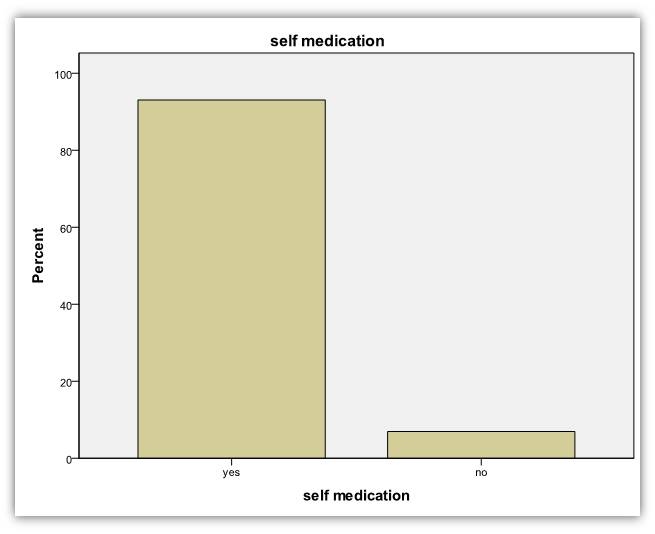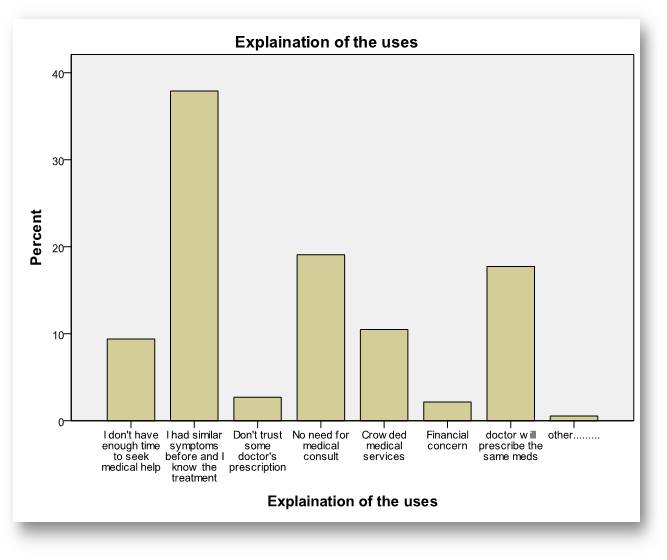Title
Frequency of using non-prescribed medication among the community of Majmaah City

Background
Self-medication prescription is practiced worldwide. Due to the growing negative impact of such practice World Health Organization (WHO) has been giving this issue due attention.
Paulo and Zaini defined self-medication as ‘the product for the treatment of a disease or for disease prevention or for promotion of health without a professional prescription’. Relatively, a high proportion of drugs are being dispensed without professional medical prescription that needs follow-up.
Educating the public about the worldwide existing problems of antibiotic resistance ( in case of using antibiotic ),drug adverse effects and unnecessary cost associated with medicines sales without medical prescription is urgently needed.
This study aim to determine the frequency of using non-prescribed medication in Majmaah city.
Summary of Work
The cross-sectional study was conducted in Majmaah city, Saudi Arabia, from January to May 2014, and comprised adults of either gender .The data was collected by investigators themselves . The data was collected from the available respondent during the data collecting time For data collection ,a questionnaire was designed and its reliability was checked by Cronbach Alpha.SPSS20 was used for statistical analysis.
Summary of Results
Majority of respondents were males (n= 276, 70.8 %), while (n=114, 29.2 % ) of them were females. The mean age of participants was 29.90 ± 11.562 years with minimum of 18 years and maximum of 83 years.
In estimation of the awareness of possible side effect of the medication (n=224,57.6%) of respondents were not aware, while (n=165,42.2%) of respondents were aware about the side effects of medications . Half of the respondents read the instruction that came with medication (n=195, 50.0%), while (n=195,50.0%) did not read the instruction that came with medication respectively.
Majority of respondents source of non prescribed medication were Public Pharmacy (n=152, 41.8%), (n= 66, 18.1%) were using as advised by Family members.
Most used non-prescribed medication was antibiotic + pain killer + antipyretic (n=83, 22.4%) while the least used non-prescribed medication was Antihypertensive (n=1.0.3%).
Most respondents were using non-prescribed medication to treat fever+ pain + headache (n=67, 18.0%).
Significant association was observed between gender and use of non prescribed medication, p=0.002 .
There was no association between used non-prescribed medication and marital status, education level, occupation and monthly income. (p > 0.05) respectively.


Acknowledgement
Our appreciation and thank to the faculty member of community medicine in Majmaah university ,Riyadh, Saudi Arabia who help us with their knowledge to accomplishment for this study.
Conclusion
The frequency of using non-prescribed medication in Majmaah city is high . Antibiotic, pain killer and antipyretics are the most used medications. Male used non-prescribed medication more than female . Socioeconomic status and educational level have no relationship with using non-prescribed medication.
References
1.Kamat VR, Nichter M. Pharmacies, Self medication and pharmaceutical marketing in Bombay, India. Soc Sci Med 1998;47:779–94.
2.World Health Organization. The role of the pharmacist in selfcare and self-medication. Report of the 4th WHO Consultative Group on the role of the pharmacist in health care system (1998).
3.Paulo L, Zanini A. Self-Medication in Brasil. AMB Rev Assoc Med Bras 1988; 34:69–75. [Article in Portuguese].
4.Drug Utilization Research Group. Multicenter study on self-medication and self-prescription in six Latin American countries. Clin Pharmacol Ther 1997; 61:488-93.
5.Kamat VR, Nichter M. Pharmacies, self-medication and pharmaceutical marketing in Bombay, India. Soc Sci Med 1998; 47:779-94.
6.Greenhalg T. Drug prescription and self-medication in India: an exploratory survey. Soc Sci Med 1987; 25:307-18.
7.Segall A. A community survey of self-medication activities. Med Care 1990; 28:301-10.
8.Wilkinson IF, Darby DN, Mant A. Self-care and self-medication: an evaluation of individuals’ health care decisions. Med Care 1987; 25:965-78.
9.Rozemberg B. O consumo de calmantes e o “problema de nervos” entre lavradores. Rev Saúde Pública 1994; 28:300-8.
10.Acevedo DV, Valle AA, Toledo JLM. Características de la adquisición de medicamentos en Morelia (Michoacán, México). Bol Oficina Sanit Panam 1995; 119:237-42
11.Aref A Bin Abdulhak, Mohamad A Altannir, Mohammed A Almansor, Mohammed S Almohaya,,Atallah S Onazi, Mohammed A Marei, et al. Non prescribed sale of antibiotics in Riyadh,Saudi Arabia BMC Public Health. 2011; 11: 538.
12.Bi P, Tong S, Parton KA. Family self-medication and antibiotics abuse for children and juveniles in a Chinese city.Soc Sci Med 2000; 50: 1445–50.
13.Kogan MD, Pappas G, Yu SM, Kotelchuck M. Over-the-counter medication use among Spreschool-age children. JAMA 1994; 272: 1025–30.
14.Rylance GW,Woods CG, Cullen RE, Rylance ME. Use of drugs by children. BMJ 1988; 297:445-7.
15.Ebert, S.C. Factors contributing to excessive antimicrobial prescribing. Pharmacotherapy 2007,27, 126–130.
16.Friedman, C.R.; Whitney, C.G. It’s time for a change in practice: Reducing antibiotic use can alter antibiotic resistance. J. Infect. Dis. 2008, 197, 1082–1083.


 Send Email
Send Email